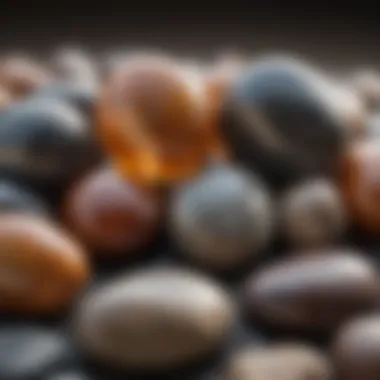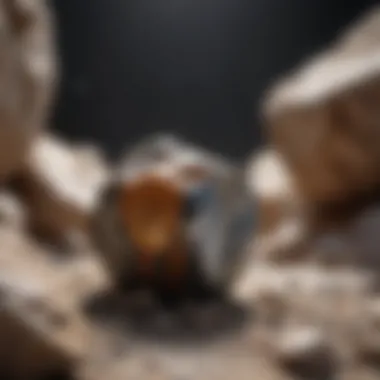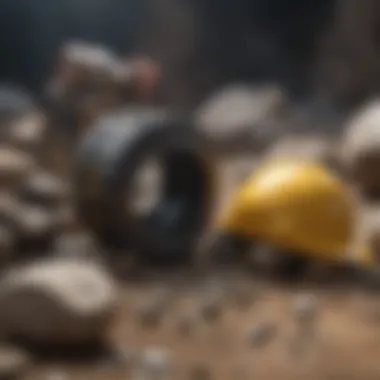Discover the National Geographic Rock Tumbler Kit


Intro
The National Geographic Hobby Rock Tumbler Kit is more than just a gadget for turning rough stones into polished gems; it serves as a bridge between the curious novice and the intricate world of geology. This article offers a detailed look at this all-in-one kit, focused on the benefits it brings to budding mineral enthusiasts. From understanding the rock tumbling process to practical tips for successful outcomes, we aim to provide a comprehensive resource for anyone interested in this rewarding hobby.
Not only does rock tumbling unveil the beauty hidden in everyday rocks, but it also cultivates a deeper appreciation for the natural sciences—a passion that can thrive in both young and old explorers alike. With features tailored for novice collectors and seasoned enthusiasts, the kit is an accessible entry point into a captivating realm that connects us to the Earth itself.
Prologue to Rock Tumbling
Rock tumbling is more than just a pastime; it's a deep dive into the world of geology, mineralogy, and patience. For many, the act of turning rough stones into polished gems can be transformative. This journey begins with an understanding of the basic principles, the tools, and, importantly, the reasons why this hobby captivates both young and old.
Understanding the Basics
At its core, rock tumbling involves a series of mechanical processes that smooth and polish stones. The process uses a rock tumbler, a device designed to facilitate this transformation through grinding, smoothing, and polishing actions. The central materials include rough stones and a combination of grits that progressively refine their surfaces. This hobby introduces enthusiasts to the beauty of natural minerals and their properties. It serves as a hands-on lesson in geology, showcasing how stones can tell tales of their time on Earth, shaped by elements and time itself.
Rock tumbling requires an understanding of specific stages: coarse grinding, fine grinding, and polishing. Each stage plays a crucial role in achieving that glossy finish. Knowing when to switch grits and how to select compatible stones is fundamental. Enthusiasts must also grasp the importance of patience—often, the best results come after weeks of consistent tumbling.
The Appeal of Rock Tumbling
What draws people to rock tumbling? It’s a blend of education and leisure. For many, there’s a certain thrill in discovering a rough stone, envisioning its potential, and transforming it into something beautiful. The tactile experience of handling different stones, combined with the anticipation of what lies inside, is a significant lure.
Many hobbyists appreciate the simplicity yet complexity of rock tumbling. One can start this journey with minimal investment, but the learning curves and intricacies can keep it engaging for years. Additionally, the community aspect is not to be overlooked. Interactions with fellow enthusiasts—from sharing tips to organizing local meets to even discussing rare finds—create lasting connections.
"In every stone, there lies a story waiting to be told. Tumbling helps you unveil it step by step."
This hobby is also about the therapeutic benefits of working with one’s hands and focusing one’s mind on a tangible process. It fosters a sense of achievement when you see the results at the end of a tumbling cycle. Whether it’s a shiny piece to add to a collection or a unique gift for someone special, the appeal is palpable.
In summary, rock tumbling is a fulfilling endeavor. It nurtures curiosity, creativity, and a connection to the natural world, blending education with personal enjoyment.
Overview of National Geographic Hobby Rock Tumbler Kit
When stepping into the world of rock tumbling, having the right equipment can mean the difference between a rewarding hobby and a frustrating ordeal. The National Geographic Hobby Rock Tumbler Kit stands out as a comprehensive choice, offering enthusiasts an accessible entry point into this captivating practice. This section will unravel the importance of this kit, emphasizing its key elements, benefits, and considerations that resonate with both newcomers and seasoned collectors alike.
Key Components of the Kit
The National Geographic Hobby Rock Tumbler Kit is designed meticulously, featuring essential components that work together to ensure a seamless tumbling process. Here’s a breakdown of what one can expect:
- Tumbler Drum: The heart of the kit, this drum is where all the magic happens. Made from durable materials, it's built to withstand the rigors of repeated tumbling while minimizing noise, making it suitable for home use.
- Grit Pack: Accompanying the tumbler, the grit pack is crucial for the grinding and polishing stages. It includes coarse, medium, fine, and polishing grit, providing a comprehensive range of options to achieve those shiny, polished stones.
- Instructions Manual: Often overlooked, the manual is a treasure trove of tips and best practices. It guides users through each step of the tumbling process, ensuring even novices can navigate their way to success.
- Sample Stones: Many kits come with a selection of stones to kick-start the tumbling experience. This collection is not just any rocks; they are chosen for their suitability to inspire and engage beginners.
Each of these components plays a vital role in delivering an effective tumbling experience, creating a setup that encourages exploration and learning.
Specifications and Features
Beyond the basic tools, the National Geographic Hobby Rock Tumbler Kit is laden with specifications that enhance its usability and effectiveness. Here are some noteworthy features:
- Capacity: The tumbler offers a generous capacity, allowing users to tumble multiple stones simultaneously. This ensures that hobbyists can maximize their time and resources.
- Noise Reduction: A significant feature for home users is the noise insulation. Unlike many traditional models that can be quite loud, this tumbler operates quietly, making it a suitable option even for living spaces.
- Customization Options: Some kits allow for customization in terms of speed settings and tumbling times, giving users control over the polishing process based on their specific needs.
"A well-designed tumbler kit can transform not just stones, but also your understanding of geological beauty and processes."
The National Geographic Hobby Rock Tumbler Kit, therefore, merges functionality with an educational twist. It doesn’t just focus on the end product of shiny stones but encourages a deeper appreciation for the natural world, making it a valuable tool for rock and fossil collectors.
How to Use the Rock Tumbler Kit
Understanding how to use the National Geographic Hobby Rock Tumbler Kit effectively is crucial for anyone looking to embark on the exciting journey of rock tumbling. This section equips you with the essential knowledge, providing a clear pathway to transforming rough stones into beautiful, polished gems. Tumbling not only serves as a creative outlet but also enhances your appreciation for geology and the natural world.
Step-by-Step Guide to Tumbling
The process of tumbling rocks, while straightforward, involves a series of steps that need careful attention. Here’s a detailed guide to help you through each stage:
- Gather Materials: Start with your tumbler kit. Ensure you have your rough rocks, grit, and the necessary tools.
- Select Your Rocks: Choose a mix of stones. It’s often beneficial to have different sizes and hardness. Mismatched stones can yield more diverse results, but be cautious; certain rocks can scratch softer ones.
- Prepare the Tumbler: Fill the tumbler barrel halfway with your chosen rocks. This ensures optimal movement and polishing during tumbling.
- Add Grit: Following the manufacturer’s guidelines, add the appropriate amount of coarse grit to the tumbler. The grit is vital as it grinds the rocks down, starting their transformation.
- Seal and Start: Securely close the tumbler barrel, plug it in, and allow it to run for the set period, usually about a week.
- Repeat the Process: After the first run, clean the rocks and repeat with finer grits. Fine grinding and polishing are key to achieving that smooth, mirror-like finish.
Selecting Rocks for Tumbling


One of the most enjoyable parts of rock tumbling lies in selecting the right stones. Not just any rock will do; the choice can make or break your tumbling experience. Let's delve into what makes a good candidate for tumbling.
Recommended Starter Stones
When first navigating the world of rock tumbling, certain stones stand out as ideal for beginners. Think of quartzes like agate and jasper. Their hardness, usually around 7 on the Mohs scale, ensures they can endure the tumbling process while still yielding good results.
- Characteristics: These stones are typically colorful and can develop a glassy finish that attracts the eye. The variety of patterns found in agate, for example, creates visual appeal.
- Benefits: They are not only beautiful but relatively forgiving. Newcomers can practice their technique without the frustration of frequent failures.
- Unique Feature: Agate, for instance, often has bands of colors, which become increasingly pronounced through polishing.
In summary, starter stones like agate and jasper offer both resilience and aesthetic charm, making them excellent choices for novice tumblers.
Common Mistakes to Avoid
As with any hobby, there are pitfalls that can lead to frustrating experiences in rock tumbling. Recognizing these missteps can save time and disappointment.
- Overfilling the Tumbler: One might feel tempted to batch tumbling too many stones, but this can hinder effective grinding. Ideally, the tumbler barrel should only be filled to about two-thirds capacity.
- Mixing Hardness: Combining rocks of varying hardness may cause the softer stones to be scratched or damaged. It’s important to pair similar hardness levels to ensure a smooth tumbling process.
- Skipping Grit Stages: Each stage of grit has a purpose. Jumping from coarse directly to polish can result in unsatisfactory outcomes.
"Learning from mistakes is part of the journey; avoiding these blunders will lead to smoother sailing in your tumbling adventures."
The Tumbling Process Explained
The tumbling process is at the heart of maximizing the potential of the National Geographic Hobby Rock Tumbler Kit. This stage of transforming rough stones into polished gems is not just a mechanical operation—it’s a blend of science and art that can deepen your appreciation for geology. Understanding the nuances of this process helps hobbyists not only achieve better results but also fosters a deeper connection with the materials they work with.
When we talk about the tumbling process, we often break it down into distinct stages: coarse grinding, fine grinding, and polishing. Each of these stages plays a pivotal role in the final appearance and quality of the stones. By grasping the significance of each stage, one can effectively manage expectations and troubleshoot effectively.
Stages of Rock Tumbling
Coarse Grinding
Coarse grinding sets the foundation for all the subsequent processes. This initial step involves using rough abrasives to remove the outer layer of the stones, effectively reshaping them. The key characteristic of coarse grinding is its ability to handle tougher, unrefined stones, making it a necessary first step for most tumblers.
This stage is a beneficial choice for those just starting because it teaches the user about the textures and physical properties of different rocks. Coarse grinding can reveal the hidden beauty of stones that may seem dull at first glance. That said, it does have its drawbacks; some softer stones may get damaged or over-ground if not closely monitored. This makes care and attention essential during this phase.
Fine Grinding
After the rough edges have been smoothed out by coarse grinding, fine grinding steps in to take things to the next level. During this stage, finer abrasives polish the stones even more, helping to eliminate scratches left over from the coarse grinding. A key characteristic of fine grinding is its focus on preparing stones for their final transformation.
This stage is vital because it enhances the overall luster and quality of the stones. As the stones begin to shine, the anticipation builds, making it an exciting part of the process. However, fine grinding is also time-sensitive; leaving stones in this phase too long can lead to excessive wear, diminishing the beauty achieved during earlier stages. Therefore, successful fine grinding relies on careful timing and observation.
Polishing
The polishing stage is where the magic truly happens. This is when the stones are finally buffed to a high shine, accentuating their colors and patterns. The key characteristic of polishing is its transformative power—the dull and uneven stones from earlier stages become lustrous and smooth.
Choosing to polish is often considered the culmination of the tumbling process and can provide immense satisfaction. It encapsulates the effort put forth in the earlier stages, and the results can be quite rewarding. However, polishing requires the right materials and techniques; if done improperly, stones can end up with a cloudy finish rather than a brilliant shine. Thus, precision is key as you navigate this final stage.
Timeframes for Each Stage
The time required for each tumbling stage varies but is crucial for achieving optimal results. Here’s a brief overview:
- Coarse Grinding: Often takes 7 to 10 days, depending on the hardness and type of stones.
- Fine Grinding: Typically lasts 4 to 7 days, allowing for a smoother surface.
- Polishing: Usually requires 5 to 7 days, as this is where stones gain their most eye-catching qualities.
Each phase has its timetable, and patience is essential. Keeping track of time and ensuring all phases are done thoroughly will reward you with stunning stones, perfect for adding to your collection or gifting to fellow rock enthusiasts.
Remember, every rock tells a story, and the tumbling process is the narrative that reveals its hidden beauty.
Benefits of Rock Tumbling
Rock tumbling isn't simply a pastime; it brings a plethora of benefits that resonate with hobbyists, educators, and the curious alike. This activity can be an engaging gateway to understanding geological processes, enhancing skills, and fostering mindfulness. Whether you're diving into this for fun or education, the advantages are noteworthy.
Educational Aspects
Learning about Geology


Learning about geology through rock tumbling is an element that goes beyond just transforming rough stones into polished gems. It enhances one’s understanding of various rock types, their formation processes, mineral properties, and the vast timeline of Earth's history. The intimacy that comes from handling different rocks and minerals can spark a lifelong passion for the Earth Sciences.
When enthusiasts identify the characteristics of a rock, they engage directly with concepts like erosion, metamorphism, and sedimentation. For instance, a novice might pick up a piece of quartz, which is common, and learn how it's formed from silicon dioxide. Suddenly, they’re not just tumbling; they’re exploring the science behind the sparkly surface of their polished stones. This hands-on experience makes geology more tangible and accessible, making it a unique choice for learners.
Advantages of learning geology through rock tumbling include:
- Practical Application: It turns abstract geological concepts into practical experiences.
- Interactive Learning: Hands-on activities engage multiple senses, fostering deeper understanding.
However, it requires patience and may be overwhelming for those expecting instant gratification. But the process itself is what makes the lessons stick.
Enhancing Observation Skills
The process of rock tumbling is a meticulous endeavor; it sharpens observation skills in ways that many might take for granted. Each batch of stones tells a unique story. Noticing the subtle differences in color, texture, and imperfections begins to cultivate a discerning eye. This is critical not only in geology but also in various aspects of life.
For instance, when sorting stones for tumbling, enthusiasts have to consider factors like size, hardness, and presence of cracks or inclusions. It’s during this careful observation that one can also begin to appreciate natural beauty in imperfections or variations, nurturing an appreciation for details.
The key benefits include:
- Increased Attention to Detail: Developing a keen eye fosters better analytical skills.
- Mindfulness: Engaging in this process allows one to slow down and focus, promoting a calm mindset.
In summary, the unique feature of rock tumbling that enhances observation is its ability to transform mundane moments into opportunities for reflection and growth.
Therapeutic and Recreational Benefits
Rock tumbling also serves as a therapeutic activity. The process is often likened to a meditative practice, where the rhythm of the tumbler becomes a form of mindfulness. Engaging with this craft can help to alleviate stress, providing not just a hobby but an escape from the daily grind.
Many find joy in watching the gradual changes as rough stones metamorphose into bright, polished specimens. This tangible transformation can evoke a sense of accomplishment, serving as a reminder that, much like the rocks, personal growth requires time, patience, and consistent effort.
In summary, the benefits of rock tumbling are multifaceted, appealing to those who seek knowledge, personal development, and a therapeutic activity. Enjoying this fascinating world beneath our feet can be both fulfilling and enlightening.
Troubleshooting Common Issues
Rock tumbling can be a rewarding and fulfilling hobby, but it’s not without its hiccups. Knowing how to troubleshoot common issues can save time and enhance your experience. This section addresses potential problems that might arise during the tumbling process and offers effective solutions.
Identifying Problems in Tumbling
Before you can fix an issue, you need to recognize what's going wrong. Here are some common problems you may encounter:
- Insufficient Polishing: Sometimes, you might find that your rocks don’t shine as expected. This often occurs if the polishing stage is cut short or if insufficient polishing compound is used.
- Uneven Surfaces: If your stones end up with an uneven finish, it could result from improper loading of the tumbler or using rocks of varying hardness together.
- Excessive Noise or Vibration: A loud tumbler or one that shakes excessively can signal misalignment or an overload of rocks. Listening closely to these signs can indicate whether your setup needs adjusting.
- Mud or Sludge Build-Up: If you notice a thick layer of mud around the tumbler, your mixture might be too dense or not mixed correctly, affecting the final result.
"Not all who tumble get it right the first time; it's all part of learning the ropes."
By recognizing these common signs, you can pinpoint the underlying issues more readily, leading to smoother solutions.
Solutions and Best Practices
Once you've identified the problems, implementing effective solutions can salvage your tumbling session. Here are some best practices:
- Tweaking the Time: If your rocks aren't polished adequately, consider extending the tumbling time. Experimentation is key here; sometimes a simple extra few days makes all the difference.
- Balancing the Load: When adding rocks to your tumbler, try to keep similar materials and sizes together. This helps in achieving a uniform finish and prevents any uneven surfaces.
- Check the Setup: Always ensure the tumbler is properly leveled. A slight incline can lead to erratic motion and excessive noise, so set it up on a stable surface.
- Adjust the Mixture: For mud build-up, try adding more water or adjusting the grit ratio. A well-mixed slurry enhances tumbling efficiency.
In summary, troubleshooting isn't just about fixing problems; it's also about improving your overall tumbling journey. Keep these pointers in your back pocket, and you’ll find yourself navigating through issues like a seasoned pro.
Care and Maintenance of the Kit
Proper care and maintenance of the National Geographic Hobby Rock Tumbler Kit is not just a routine task; it's a commitment to ensuring that you get the most out of your tumbling experience. A well-maintained rock tumbler can enhance the quality of your finished stones and prolong the life of the equipment, which is important for anyone keen on delving deeper into this fascinating hobby.
Cleaning the Tumbler
Cleaning the tumbler after every use is crucial. After each tumbling cycle, residue and dirt tend to build up inside the barrel. If not cleaned properly, this gunk can affect the tumbling process for future batches. Start by removing the barrel from the base of the tumbler. Give it a good rinse with water to wash away the grit, especially around the seal areas where clumps of debris might be hiding. Some users even recommend using a soft brush to get into those nooks and crannies.
When the barrel is clean, dry it thoroughly before reassembling it. Water left inside can create mold and harbor bacteria, which not only smells bad but can ruin future tumbles. Thus, letting it air dry after a thorough rinse is a safe approach.


Keeping your tumbler clean not only promotes better performance but also adds an extra layer of safety to your hobby.
Proper Storage Techniques
How you store your rock tumbler is just as important as cleaning it. If you just toss it in a closet or leave it in an exposed area, you run the risk of damaging the components or collecting dust. Ideally, find a cool, dry place to store your kit. If you're storing the tumbler for a longer period, make sure to disconnect the power supply and keep all parts organized together—this includes the barrel, grit, and any additional tools.
Some enthusiasts suggest using a large tote or container to keep the kit together. This way, components won't get misplaced, and it keeps dust off the device. Remember to avoid areas with high humidity; moisture can rust metal parts and degrade the rubber lining of the barrel.
In sum, proper care and maintenance involve regular cleaning and thoughtful storage techniques. Treating your tumbler well will not only enhance your rock tumbling experience but will also ensure that your investment lasts for years to come.
Safety Considerations
When diving into rock tumbling, safety becomes a paramount concern, not just for your wellbeing, but for creating a seamless and enjoyable hobby experience. Handling equipment and minerals poses unique challenges and understanding these can help mitigate risks and amplify enjoyment. This section emphasizes several essential aspects of safety that enthusiasts should keep in mind.
Handling Minerals and Equipment Safely
Navigating the world of minerals and equipment entails careful consideration of how to manage both. Here are some points to keep in mind:
- Personal Protective Equipment (PPE): Always wear appropriate PPE when handling equipment and minerals. Safety goggles and gloves are non-negotiables. They help shield your eyes from dust and potential flying debris.
- Electrical Cautions: If you are using an electric tumbler, check all wires for wear and tear before plugging in. Short circuits can lead to hazards. Ensure the equipment is placed on a stable surface and away from water.
- Crushing and Grinding Rocks: When you're in the coarse grinding stage, the tumbler can generate vibrations that might cause it to shift. Always double-check that the tumbler is secure.
- Cleaning Up After Tumbling: After each session, clean your workspace thoroughly. Small rock fragments can easily be missed, presenting slipping hazards. Keep the area organized and free from clutter.
"Safety is not just a priority; it's a way to ensure you enjoy every aspect of your hobby without unnecessary worry."
Understanding Material Properties
Having a solid grasp of the properties of the minerals you are working with is vital. Not all rocks are created equal, and knowing how different materials react under specific conditions can save you from accidents. Some considerations include:
- Identifying Dangerous Minerals: Certain minerals can be hazardous to your health. For example, some contain quartz, which can produce harmful silica dust when ground. Familiarize yourself with the rocks you are using; avoid those known to be problematic.
- Hardness and Abrasiveness: Different stones exhibit varying levels of hardness, which affects how they behave during the tumbling process. Softer stones will wear down faster, while harder stones can damage your tumbler if not monitored closely.
- Moisture Sensitivity: Some minerals absorb water and can break down over time or during the tumbling process. Always consider the moisture content and how it might affect your materials.
By staying informed about the materials you're working with and the equipment you’re using, you ensure a safer tumbling experience, enhancing not only your safety but also the overall quality of your finely polished stones. Keeping safety front-of-mind is the first step toward a successful rock tumbling journey.
Community and Resources
The field of rock tumbling is not just about the process of transforming rough stones into polished gems; it’s also about connecting with others who share the same passion. Understanding and engaging with the community and resources around this hobby can significantly enhance the experience for beginners and seasoned tumblers alike. It’s this social web that fosters a deeper appreciation for geology and encourages learning from shared experiences and insights.
Connecting with Other Enthusiasts
Joining a community of enthusiasts can make a world of difference for anyone diving into the art of rock tumbling. Whether it's in person or online, sharing ideas, tips, and challenges can help budding collectors navigate the complexities of the hobby. There are several ways to tap into this well of knowledge:
- Local Clubs: Many regions host geological societies or rock clubs. These gatherings can provide hands-on demonstrations and workshops, perfect for those who prefer learning in person. You might find gem shows where enthusiasts gather to trade, share, and showcase their favorite finds.
- Online Forums: Websites like Reddit have subreddits dedicated to mineral enthusiasts. Here, you can ask questions, share findings, and receive feedback from fellow hobbyists. It’s an invaluable resource for troubleshooting and learning about different tumbling techniques.
- Social Media Groups: Platforms like Facebook host groups specifically tailored to rock tumbling and mineral collecting. These spaces are often buzzing with activity, featuring individuals showcasing their latest projects, offering advice, or holding Q&A sessions.
"Community is like a rock tumbler. It smooths out rough edges and brings out the best in everyone."
By actively participating in these communities, you build relationships that can enhance your understanding of not only the mechanics of tumbling but also the rich world of geology itself.
Online Resources for Further Learning
The internet is a treasure trove of information and guides specifically designed for those interested in rock tumbling. Various platforms offer structured learning opportunities, articles, and videos that can help deepen your knowledge.
- YouTube Channels: There are several dedicated channels where experienced rock tumblers share their insights. From beginner tips to advanced techniques, you can find tutorials that visually guide you through the processes. Watching someone tumble in real time prepares you for any surprises during your own endeavors.
- Educational Websites: Websites like britannica.com and en.wikipedia.org contain valuable articles about minerals, tumbling techniques, and the science behind the transformation of rocks. These pages can serve as a solid foundation, offering historical context as well as practical advice.
- Online Courses: Some platforms offer online courses dedicated to tumbling and geology. These are structured to help guide you from novice to pro, covering various aspects of rock selection, grinding stages, and polishing tips.
Epilogue
Understanding the journey of rock tumbling is not just about polishing stones; it's a gateway into the intriguing world of geology and nature's artistry. This article has taken a thorough look at the National Geographic Hobby Rock Tumbler Kit, emphasizing its role in enriching the hobby experience. The kit stands out for its ease of use, diverse features, and ability to engage both novices and seasoned collectors alike.
Recap of Key Points
In summarizing the critical aspects of rock tumbling, several points stand out:
- Comprehensive Guidance: From the onset of this article, we've navigated through the essential components of the National Geographic tumbler. Each feature serves to enhance the user's experience.
- Tumbling Process Insights: Understanding the stages from coarse grinding to polishing reveals the meticulous nature of transforming rough stones into beautiful gems.
- Educational Value: Rock tumbling is not merely a hobby; it's a practical method for learning about geology, which can spark a passion for further exploration in natural sciences.
- Community Connection: The emphasis on connecting with other enthusiasts and utilizing online platforms fosters a supportive network that enhances learning and sharing experiences.
Encouragement for New Hobbyists
If you’re standing on the fence about diving into rock tumbling, remember, every expert was once a beginner. This hobby, with its blend of science, creativity, and patience, invites exploration at your own pace. Start with simple stones and minimal equipment; the joy comes from the process, not just the polished results. The National Geographic Hobby Rock Tumbler Kit equips new hobbyists to embark on adventures that connect them with Earth’s history.
"The stones you discover through this hobby could spark your curiosity about the world beneath your feet."
Ultimately, engaging with rock tumbling could very well kindle a lifelong interest in earth sciences or simply offer a gratifying way to unwind. Don't hesitate to explore and ask questions, whether online or in local clubs. The community is ready to welcome you with open arms.
As you pick up that first handful of rough rocks, think of it as not just a start but an entry into a journey filled with beauty, discovery, and knowledge.



